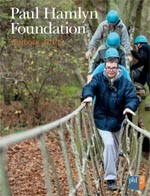Learning for foundations
As our own impact report reveals, it can be difficult for foundations to develop processes for effectively evaluating and learning from the grants they make. Here, David Carrington, a consultant to the philanthropic sector, shares his perspective on the development of approaches to learning and evaluation among charitable trusts and foundations as a whole, revealing a pattern of regular adjustment as foundations’ practices have shifted and impacted on grantees.
It is usually unwise to attempt any generalisations about charitable trusts and foundations. They are quick to assert not only their independence but their individuality – the differences in the aims and aspirations of their founders, the differences in size, organisation and policies. Nonetheless, a number of developments over the last couple of decades have informed the practice, generally, of UK trusts and foundations. As part of a team of researchers, I have been working on the ‘Shedding Light on our Own Practice’ study, in which we interviewed 26 foundations from across Europe (including Paul Hamlyn Foundation) about their approaches to learning and evaluation. Our findings were launched at the European Foundation Centre annual conference in Belfast in June 2012, and a full report is due later in the year.
During the 1990s, trusts and foundations put a lot of effort into three main areas: clarity of communications, fairness in funding, and a sharper focus on supporting clearly defined projects with specific outputs. All these developments were intended to ensure that foundation funding was used in more deliberate and thoughtful ways than may have been the case previously. However, each also had some ‘downsides’, especially from the perspective of the organisations seeking funds.
For example, they could lead to inflexible, tortuous and time-consuming application and decision-making processes, making it more expensive, particularly for smaller organisations, to engage in transactions with foundations. Worse, applications themselves could lead to the organisation’s work being distorted as it tried to shape and redefine what it thought needed to be done in order to meet the foundation’s requirements and priorities.
Short-term, project-focused funding could easily lead to applicants asserting that they could achieve complex and ambitious targets within a limited timescale that in their hearts they knew was insufficient (and often with a level of funding that they knew would be inadequate). Output- focused work could lead to a disproportionate focus on narrow compliance and reporting – further increasing transaction costs for grantee organisations without necessarily adding any real value.
During the last decade, many foundations have sought to enhance further the ways they work so that these downsides are avoided. A greater focus has emerged on relationships with grantees that seek to strengthen the resilience of the funded organisations, look beyond quantifiable outputs to more subtle indicators of lasting outcomes, and generate mutually useful learning.
Foundations have also explored other ways they can add value to the work they support by introducing various forms of what has been described as ‘funding plus’, for example by creating opportunities for the organisations they support to share knowledge and experience (either in person or virtually), and by using the experience that has been achieved with the support of their funding to engage in advocacy and other attempts to influence the direction of public policy.
Some foundations have also extended the menu of the types of funding they provide to go ‘beyond grants’ and include (either directly or via intermediaries) loans, underwriting or other forms of investment and ‘patient capital’ – adopting various forms of what is called ‘programme related investment’. This is intended, primarily, to help an
